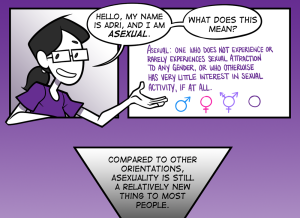
A student sits at a desk, running their fingers through their hair and appearing stressed as they write in a notebook with their other hand. Another student is out of focus in the background.
As someone who’s done a great deal of anti-rape protests at my previous universities, I’ve seen hundreds of different examples of rape culture on campus.
Unfortunately, many people disagree that rape culture at universities and colleges is a widespread issue. This is because many forms of rape culture are normalized in our society.
Rape culture is defined really well on Wikipedia as follows:
“In feminist theory, rape culture is a setting in which rape is pervasive and normalized due to societal attitudes about gender and sexuality. The sociology of rape culture is studied academically by feminists […] Behaviors commonly associated with rape culture include victim blaming, sexual objectification, trivializing rape, denial of widespread rape, refusing to acknowledge the harm caused by some forms of sexual violence, or some combination of these.”
Rape culture is a dangerous element that’s present throughout our society. Educational institutions are no exception.
Let’s look at a few common examples of rape culture on campuses and think about how we can tackle them.
Of course, not all of these things are prevalent at every university, but that doesn’t necessarily mean that rape culture is absent from those campuses. It simply means that it manifests in different ways.
1. Orientation, Traditions, and Initiation
From cheers and war cries that gleefully describe raping others, to initiation ceremonies where students are expected to have sex, a number of traditions and initiation rituals during university orientation are demonstrative of rape culture.
The topic of initiation also brings into question the idea of force.
In any situation where someone is forced to do something against their will for no good reason, we’re perpetuating rape culture. When we force initiation ceremonies onto people, we’re denying their autonomy. When we make them do things despite them saying no, we’re saying their consent doesn’t matter.
Indeed, sometimes we need to force people to do things to prevent them from hurting themselves and others. But initiation ceremonies and traditions are a far cry from those emergency situations.
2. A Lack of Adequate Disciplinary Measures
When I think of powerful examples of anti-rape activism on campuses, I often think of Emma Sulkowics.
In 2014, Sulkowics became well-known for carrying her dorm mattress around Columbia University’s campus, as a visual form of protest against her university’s refusal to expel her rapist.
She detailed how Columbia administrators were insensitive in how they handled her case:
“One took incomplete notes of her story, writing that she was tipsy that night. Adjudicators ‘kept asking me to explain the position I was in,’ she says. ‘At one point, I was like, ‘Should I just draw you a picture?’ So I drew a stick drawing.’ She says one of the three judges even asked whether Paul used lubricant, commenting, ‘I don’t know how it’s possible to have anal sex without lubrication first.’”
She’s not alone. She’s one of many students that faced a system that was skewed against victims and in the favor of perpetrators.
The Hunting Ground is a documentary that revealed how many rape cases had been mismanaged by Australian universities. Many victims were met with insensitive comments from administrators, and in one case a student found guilty of rape was simply required to pay a $25 fine.
The mishandling of rape cases is one of many reasons why people are questioning whether universities should handle rape cases at all.
3. Secrecy Around Rape Statistics and Policies
I’ve done a great deal of work around campus rape, and I’m used to skeptics asking the same question: But what are the statistics?
This is hard to answer because the statistics on campus rape are often really difficult to find. At my alma mater, we were told that the university doesn’t release rape statistics to protect the anonymity of victims despite the fact that nobody asked for names.
The lack of statistics is often intentional: Many universities sweep the issue of campus rape under the carpet to protect their reputation, effectively denying the problem of rape on campus.
In certain countries, universities are legally obliged to make their statistics public. But even in those cases, the statistics can still be distorted. Not everyone who experiences sexual violence will report it – especially when they’re afraid of being disbelieved, or when they’re unsure of how to report it.
Additionally, some universities may cover up cases of rape to protect their reputation. This can result in rape statistics being inaccurate.
4. Victim-Blaming by Staff
In my time at university, I’ve heard of countless instances of victim-blaming. In one case, a campus security official referred to a rape case as “another girl getting herself into trouble.” In another, a residence warden tried to punish a rape victim for having her rapist in her dorm room past visiting hours, saying it “wouldn’t have happened if she adhered to the rules.”
Then, there are countless examples of people – especially women – being told that they need to avoid getting drunk in order to avoid rape.
When people – especially people in positions of authority – demonstrate victim-blaming, two scary things happen.
Firstly, those who have been sexually violated might internalize the victim-blaming. This is to say it might make us blame ourselves. It also makes us feel unsafe. This discourages us from speaking out and seeking help and support.
Secondly, it comforts rapists. The more we suggest that rape is justified by what the victim wears or how they act, the more rapists feel that their actions are okay.
When these attitudes are espoused by university officials, lecturers, staff members, security personnel, counselors, and disciplinary bodies, we alienate victims and comfort rapists.
I once heard extremely good advice from a fellow feminist and anti-rape activist:
Before you say something about rape, ask yourself who would feel comforted by what you’re saying: someone who was raped, or someone who committed rape. If it’s the latter, don’t say it at all.
Many university staff members should heed this advice.
5. Toxic Hook-Up Culture
“Hook-up culture” is often prevalent in universities.
By “hook-up culture,” I’m referring to a culture where it’s socially acceptable to have casual sexual encounters – often with multiple people. This sort of openness and sexual liberation can be great in certain circumstances.
But when patriarchal thinking inserts itself into hook-up culture, it becomes toxic and harmful. It’s a problem when people promote casual sex, or any kind of sex, without understanding and promoting consent and respect.
To clarify, I don’t believe that hooking up – or “hook-up culture,” for that matter – is inherently oppressive. But I do believe that many spaces, including many university spaces, have a toxic hook-up culture that ends up promoting rape culture.
An example of hook-up culture is when someone goes to a club and hooks up with a random stranger. That’s fine. But patriarchy and entitlement might lead that random stranger to believe that their hook-up partner “owes” them sex because they bought them a drink. The random stranger might also think it’s okay to penetrate their partner even when the partner is way too drunk to consent. This isn’t hooking up – it’s rape.
Hook-up culture can sometimes be quite liberating, but if we don’t approach it critically, it can end up promoting rape culture. It can also be isolating – and downright dangerous – for asexual people and people who don’t want to have sex.
6. Not Prioritizing Education on Consent
While some colleges attempt to educate their students on consent, they’re too few and far between. In a world where our primary schools and even high schools seldom focus on consent education, it’s shameful when institutions of higher education don’t even attempt to fill the gaps in our knowledge.
It’s not like colleges and universities don’t have the capacity to educate people.
As my brilliant friend Vanessa Banda put it, “During university orientation, we’re told not to plagiarize. We have to attend workshops telling us how not to plagiarize. We’re given booklets and lectures on how to avoid plagiarism. So why don’t they do the same thing around rape?”
This is true. We’re warned about plagiarism to the point where ignorance isn’t an excuse for plagiarizing. We can apply a similar approach when it comes to teaching people about consent: just as we show people how to avoid committing plagiarism, we can show them how to practice consent.
7. Stifling Protest Action and Student Organization
This is something that’s important to me personally, because I was directly affected by this issue in April 2016.
I was involved in anti-rape activism at Rhodes University in Grahamstown, South Africa. A campaign, called Chapter 2.12, began in mid-April. The campaign started with about 200 posters detailing experiences of rape culture we had at the university. The next day, the posters were removed by management. In the media and to our faces, management denied rape culture being a problem.
A week later, an anonymous person submitted a list of eleven names on a university Facebook page – a list that came to be known as the RU Reference List. The list didn’t specify what those people had done, but once the list went viral, students connected the dots and believed it to be a list of rapists who were students or alumni. While we don’t know who submitted the list, it’s hard not to assume it was compiled out of frustration after management’s reaction to anti-rape activism.
The next week was filled with protests. Classes shut down. Our counseling center overflowed. #RUReferenceList trended on Twitter. We submitted demands; management didn’t agree to meet most of them. A topless protest took place. Local police were called onto campus and given orders to meet protestors with stun grenades, rubber bullets, and pepper spray. Students were arrested despite protesting peacefully.
Still, management didn’t meet the demands or acknowledge the problem. Then, an interdict was put in place to prevent students and staff members from participating in certain forms of protest. An award-winning documentary, Disrupt, covers all of the above.
I’m telling you this story because I want you to understand the psychological damage the interdict did. Our rapists were never brought to justice: We had to sit next to them in class, watch them fill leadership positions, and see them move freely while we were forever hurt by their actions.
We, however, were intimidated, maced, and arrested for challenging the status quo. I don’t think any of us will get over the feeling of betrayal and heartbreak. A number of us dropped out or failed subjects afterward.
The consequences for speaking out against rape were worse than the consequences for raping.
Universities have immense power over students and staff, which can intimidate protestors. Many students fear a record would lead to them losing funding, or being expelled.
When universities stifle and silence those who seek justice through protest and student organization, they endorse the status quo. And when that status quo supports rapists instead of those who are raped, a very clear message is sent: We will protect rapists, but not those they harm.
8. A Denial That Rape Culture Exists
Admitting that a problem exists is one of the first steps in solving that problem.
Despite the presence of all of the above, some campuses still deny that they have an issue with rape culture. Many prominent voices in the media also deny that rape culture exists, both on campus and in society in general.
The administrators at Rhodes University never acknowledged that we had a rape culture, nor did they take any responsibility for the traumatic circumstances victims and survivors had to endure.
This denial continued after I reported that 22 students had told me they were raped by other students in that year. Bear in mind that this was only in April.
They repeatedly said they condemn rape; their actions suggested otherwise. With an attitude like this, we can’t fix the system.
This is exactly why articles like this – and more so, the conversations they hopefully spark – are important. Because recognizing how rape culture manifests is the first step in tackling the problem and working towards a society where we’re free from assault and violence.
***
University is difficult. It’s even more difficult when you’re surrounded by examples of rape culture.
Because of rape culture at universities, I had to transfer to a different university and move across the country. After that, I had to take a break from university due to constantly seeing my rapist and feeling unsupported by management.
But I’m okay because I have support. Others aren’t that lucky.
For people like me, and for people like them, we need to acknowledge the presence of rape culture on campuses so that we can fight it together.
These are definitely not the only examples of rape culture that exists on campuses. We can see rape culture manifest, also, in student media, in conversations around rape from both staff members and students, and elsewhere.
Reading all these examples can be overwhelming, but as I said earlier, recognizing a problem is the first step in fixing it.
Let’s acknowledge these issues and work to fix them together.
[do_widget id=’text-101′]
Sian Ferguson is a Contributing Writer for Everyday Feminism based in South Africa. Her work has been featured on various sites, including Ravishly, MassRoots, Matador Network, and more. She’s particularly interested in writing about queer issues, misogyny, healing after sexual trauma, and rape culture. You can follow her on Twitter and Instagram. Read her articles here.
Search our 3000+ articles!
Read our articles about:
Our online racial justice training
Used by hundreds of universities, non-profits, and businesses.
Click to learn more




















